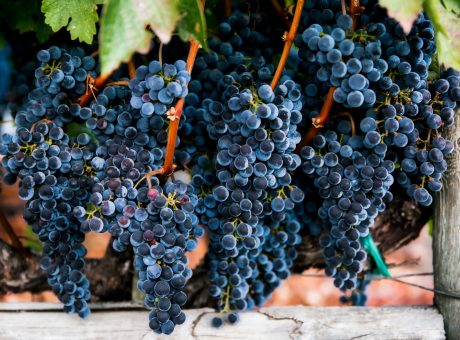Celebrate with Sparkling Wine
 Happy Holidays Ladies! It’s time to pop some bubbly…
Happy Holidays Ladies! It’s time to pop some bubbly…
Many of us love the king of sparkling wines, Champagne, but there is so much more in the wine world to explore in addition to this classic celebration wine. There are many sparkling wines from all over the world that pair very well with a variety of foods and are perfect for celebrating a special occasion, a nice dinner, or just for a fun treat.
Wine 101 fact: The term Champagne cannot be used on any wines not produced in the Champagne region of France.
Let’s explore the world of sparkling wine and how you can add a little something extra to your holiday celebrations.
French sparkling wine
 In France, the term Cremant is applied to sparkling wines produced outside of the Champagne region using the traditional method of production. Vin Mousseux is a term used for sparkling wines produced outside Champagne that may not use the traditional production method.
In France, the term Cremant is applied to sparkling wines produced outside of the Champagne region using the traditional method of production. Vin Mousseux is a term used for sparkling wines produced outside Champagne that may not use the traditional production method.
The grape varieties may differ, but the controls enforced on the production are strict, resulting in some excellent choices. The grapes most commonly used are Chardonnay, Chenin Blanc, and Cabernet Franc along with local varieties. Two favorites are Alsace because of its crispness and Vouvray because of its sweetness. French sparklings pair well with food or can be enjoyed on their own. You can taste the wine flavor with the bubbly.
Italian sparkling wine
Over the years, Italian sparkling wines have become increasingly popular in the U.S. which is why you may find more choices in your local wine shop. Many Italian wines are made using the Charmat method, instead of the traditional method, which means that during the second fermentation the wines are transferred into a tank and bottled under pressure to produce smaller, longer lasting bubbly.
Prosecco is a fantastic wine with aromas of green apple and melon. The wines do not benefit from aging and are best enjoyed while young. From the Emilia Romana region, there’s the red sparkling wine called Lambrusco. These imaginative and deeply pigmented wines hold their own when it comes to acidity and pair beautifully with parmesan and prosciutto.
Asti, as well as Moscato Di Asti, are made from the Muscat grape varietal and is a sweet, low alcohol fruit forward wine. Brachetto is a red grape varietal and makes a festive red sparkling wine within the Asti family. This wine is great as an aperitif with hints of strawberry and cherry while also pairing beautifully with cheeses and fruit.
The classic Franciacorta is made using the Champagne method. These wines will have more bubbles and a mild taste of nuts, vanilla, and ripe yellow fruit.
German sparkling wine
Sekt is the term for German sparkling wine usually made using the tank or Charmat method. The base of Sekt usually consists of grapes from France or Italy, but when using German grapes the wine will be called Deutscher Sekt. The best German sparklings are made from Riesling and can be from any of the thirteen regions in Germany. Some rare Sekt is made using the traditional method. We’ve demistified other German wines here.
Spanish sparkling wine
Cava is the term for sparkling wines from Spain and is very similar to Champagne in its production method. The majority of Cava comes from the Pendes region and has to spend nine months on the lees. The traditional grapes used in Cava are Macabeo, Xarel-lo, and Parellada for the whites. The red varietals include Garnacha and Monastrel. Most Cava is dry with medium acidity with a yeasty, yet smoky character unlike Champagne, and is not meant for aging. Cava is now also made with Pinot Noir and Chardonnay grapes adding fruit and acidity to these very food friendly wines. These wines are truly delicious with seafood, like calamari or mussels, but pairing it with a turkey chili for a weeknight treat is also fabulous.
American sparkling wine
The U.S. produces many great sparkling wines using the traditional, carbonation, transfer, or Charmat methods. The word “Champagne” is still used on the label for long established brands on the market, but newer labels after 2006 cannot use the word Champagne, adopting the worldwide standard for this designation. California is the largest US producer of sparklings, but Washington, Oregon and the Finger Lakes area of New York also produce some fantastic sparkling wines; some even having quality levels being comparable to vintage Champagne with complex fruit flavors and firm acidity with lighter bodied elegance. Middle Sister Glamour Girl Bubbly is a blend of sparkling sweet white wines from California that pairs with fried chicken, sushi, herb and cheese frittatas.
Australian sparkling wine
Australian sparkling wines range from white, rose, and red as well as dry to sweet often resulting in three styles; crisp acidity with light fresh simple fruit, full bodied with noticeable yeasty qualities and full bodied fruit forward sparkling reds. The sugar levels may offset the tannins and the alcohol in the red wines which can be made from Shiraz, Cabernet Sauvignon, and Merlot grapes. Rosè is made mainly from Pinot Noir grapes and can have salmon pink colors with floral and red fruit notes. A naturally high acidity is very important to the quality of these wines and the more complex wines may have nutty or spicy aromas.
Other great sparkling choices becoming more popular are from New Zealand, Portugal, and South Africa. Sparkling wines, unlike champagne, don’t override the taste of food, but rather complement it, and allows the flavor of the food to come through. The majority of sparkling wines are white or rose’, but Italy and Australia produce fabulous red varieties. Sparklings can range from brut (dry) to doux (sweet, dessert wine). The U.S. does not regulate the sugar content, but you’ll find most American producers follow the standard European requirements.
Next time you shop for wine, give sparklings a try. It may take a few attempts to find the right one for your palate, but it’s worth the effort. If you ever pick up a red sparkling Moscato, try adding a little fresh squeezed lemon juice and blueberries or blackberries, it’s amazing!
– Sara Lehman




Leave A Comment